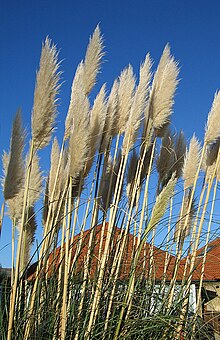User:Joliveira498/sandbox

Cortaderia selloana (pampas grass)
[edit]Taxonomy
[edit]Domain: Eukaryota
Kingdom: Plantae
Phylum: Spermatophyta
Subphylum: Angiospermae
Class: Monocotyledonae
Order: Cyperales
Family: Poaceae
Genus: Cortaderia [1]
History
[edit]Pampas Grass is listed as a Class C noxious weed, which is also known as Cortaderia selloana. It is a plant native to the area of the pampas of South America[2]. There are many different species of this grass, all of which have become invasive throughout North America. This plant has also been banned in Hawaii and New Zealand because of its ability to outgrow and displace native plants. In Europe, it was first introduced in the United Kingdom, later spreading to other countries in the continent like Ireland, Portugal, Spain, France, and Italy [1].
Invasiveness
[edit]Pampas grass can seed freely and outcompete native plants. Pampas grass can also create a fire hazard in some areas and interfere with grazing lands. This is especially true in California, Africa, and New Zealand, where pampas grass is recognized as an invasive plant. It was initially introduced to the United States to serve as a barrier between different plant species and control soil erosion. Unfortunately, it has the potential to block drivers' visibility as it grows thick and dense in a short period. The plant is known as a habitat generalist, being able to grow in a variety of environmental conditions. Some examples are that it is tolerant of shade, long-living, fast-growing, and has a high reproductive potential/genetic variability [1].
Characteristics
[edit]Pampas Grass thrives in moist, hot environments where there is direct sunlight, although it can adapt and live in any habitat. Interestingly, it can remain green year-around and remain drought tolerant. An individual grass stand can create millions of seeds that travel many miles through the wind [3]. Pampas grass grows to an average height of 10 feet. The leaves could also reach a length of 10 feet, but the width is less than 1 inch. This species can live for over a decade, being a favorite plant for people to grow in their gardens. The leaves have a bright to deep green color with a soft appearance, but are very sharp and have the potential to cause breaks in the skin. The tip is bristly and curled for males, but females tend to lack this feature. The male can distinguish the female plant because the flowers are thicker. Also, females tend to be densely hairy at the base. Plant flowering occurs from late summer to early fall [4]. The establishment of seeds usually occurs in the springtime. The seeds require plenty of sunlight to flourish because highly shaded areas result in low survival plant rates [4].
Uses
[edit]Pampas grass is considered ornamental because of its attractive plume-like flower appearance. It has no known edible or medicinal use, but the fibers are often extracted to make paper. Interestingly, people commonly use the grass in their garden beds and lawns to separate their pets from humans [2].
Negative impact
[edit]Pampas grass is fast-growing and can form large masses along the roads, cliffs, riverbanks, and open areas that have been disturbed by human activities or natural disturbances. Pampas grass can displace native plants and create their habitats, which deplete biodiversity [1]. The blade-like leaves may cause physical harm to the birds who feed off of it. The plant also competes with other native plants by monopolizing resources like shade, sunlight, and ground nutrients. Because of the large surface area, the leaves pose a significant fire hazard if placed near flammable substances [3].
Control Methods:
[edit]Manual/Mechanical Control
[edit]Pampas grass can be controlled through pesticide treatment. To accomplish this, the grass is cut down near the base. Next, a 2% glyphosate chemical solution is combined with a silicone-based surfactant and applied to enhance the penetration potential. This method works best in the fall because there is overall better control compared to other seasons. Another control method is to cut and bag inflorescences to prevent seeds from spreading or pulling seedlings [5].
Cultural Control:
[edit]Culturally, soil disturbance that creates bare ground can promote invasion, so it is essential to minimize disturbance or provide competition to seedlings. In order to control disturbance, applying mulch to exposed bare ground to smother seeds and prevent germination can be done. Also, planting or seeding desirable, non-invasive plants can provide competition to reduce germination and seedling establishment [5].
- ^ a b c d Robacker, Carol (1995-08). "Long-term shoot regeneration from pampas grass (Cortaderia selloana Schult.) through manipulation of growth regulators in vitro". Plant Cell Reports. 14 (11). doi:10.1007/bf00232648. ISSN 0721-7714.
{{cite journal}}: Check date values in:|date=(help) - ^ a b "PAMPAS GRASS (Cordaderia)", Westcott's Plant Disease Handbook, Springer Netherlands, pp. 996–996, ISBN 978-1-4020-4584-4, retrieved 2020-02-15
- ^ a b "PAMPAS GRASS (Cordaderia)", Westcott's Plant Disease Handbook, Springer Netherlands, pp. 996–996, ISBN 978-1-4020-4584-4, retrieved 2020-02-15
- ^ a b Lakhal, Lajmi; Rivest, Louis-Paul; Beaudoin, David (2009-01-04). "IPCW Estimator for Kendall's Tau under Bivariate Censoring". The International Journal of Biostatistics. 5 (1). doi:10.2202/1557-4679.1121. ISSN 1557-4679.
- ^ a b "Washington State Noxious Weed Control Board". www.nwcb.wa.gov. Retrieved 2020-02-15.
